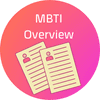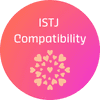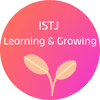‘The Duty Fulfiller’
It’s good to test yourself and develop your talents and ambitions as fully as you can and achieve greater success, but I think success is the feeling you get from a job well done, and the key thing is to do the work.” – Peter Thiel
Here, in this complete guide, you’re going to discover all about ISTJs and their personality type. You’ll learn the best way to build a memorable relationship dynamic with them, develop an advantageous partnership at work and how to speak with your ISTJ clients.
Heck, you might even want to go on an adventure with them… And, of course, if you’re an ISTJ, you’re in for a treat.
Now, the question is: how can you embody the best of ISTJ and become a better version of yourself? Well, that’s where this complete guide comes into play. You will discover:
Table of Contents
PART I: An Overview of MBTI
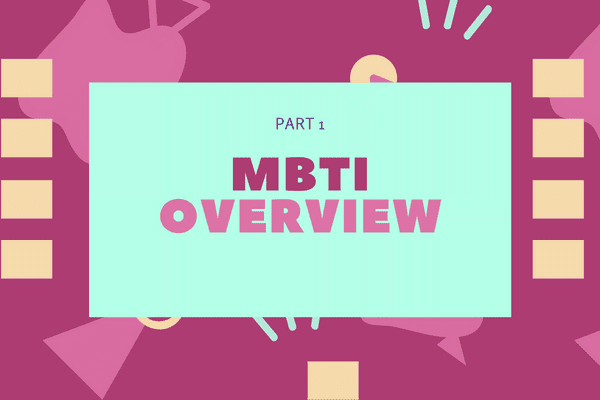
So, MBTI is based on Carl Jung’s work, “the influential theory of psychological types”, dating back to 1921. In this, his work talks about preferred types of behaviour with four main functions.
To begin with, the first two functions define the way we perform – how we take information and how we make decisions. Next, the second two functions define our energy or form of expression – extraversion and introversion.
Development of MBTI
Then, strong with the belief that Jung’s theory on the knowledge of preferences will help women find work, Isabelle Myers, with the help and guidance of her mother Katherine Briggs, embarked on a journey that led to the birth of MBTI, also known as Myers Briggs Type Indicator.
Now, one of the key advancements the mother and daughter added to the MBTI dimension is the attitude to the outer world and so the birth of a 4th preference came to light.
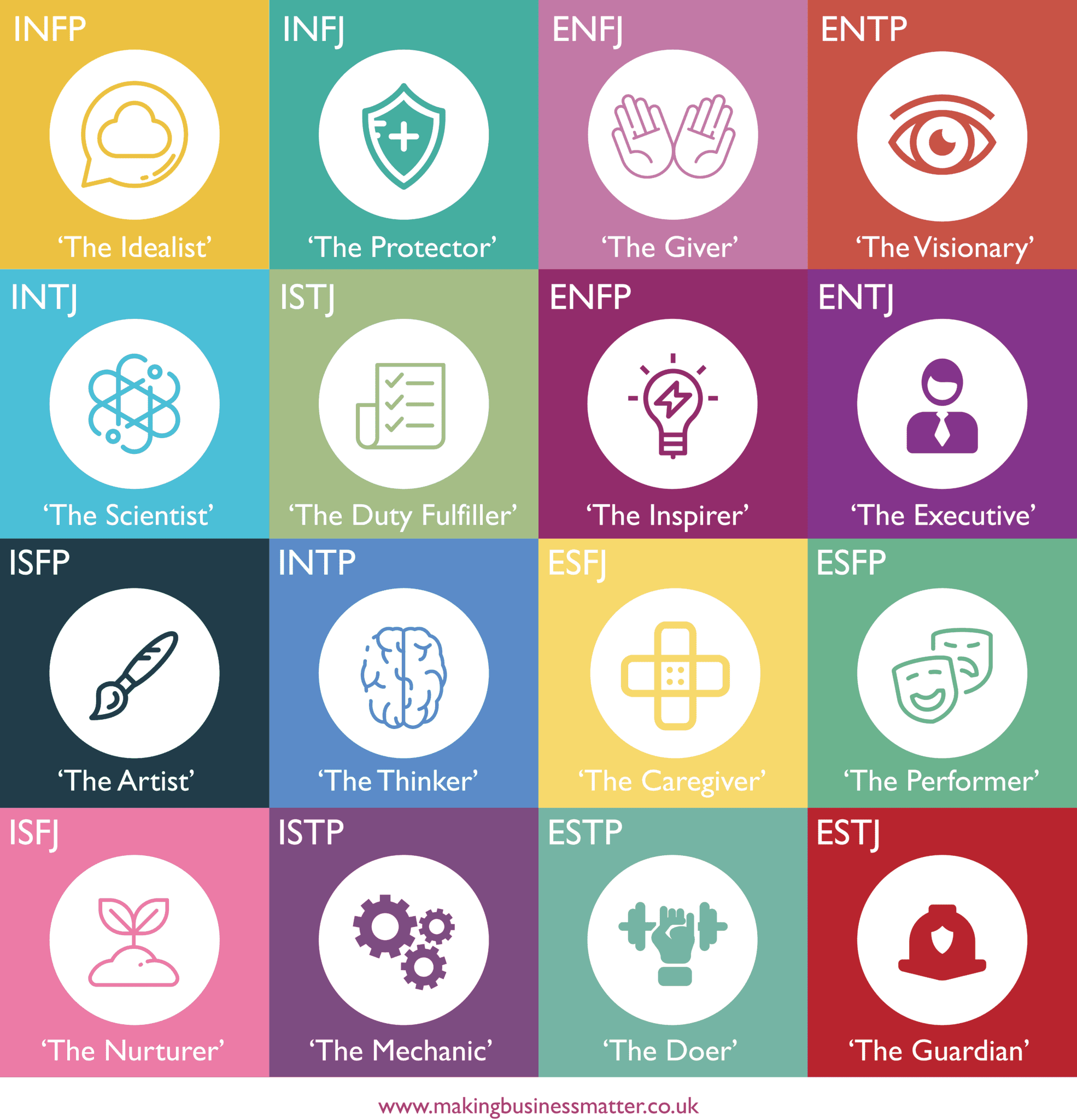
Those 16 profiles are divided into 4 different quadrants or families which we call:
- First, the Rationales (INTJ, INTP, ENTJ, ENTP)
- Next, the Idealists (INFJ, INFP, ENFJ, ENFP)
- Then, the Guardians (ISTJ, ISFJ, ESTJ, ESFJ)
- Finally, the Artisans (ISFP, ISTP, ESFP, ESTP).
So, while we are born with a certain set of tendencies, we also develop subsequent tendencies as we grow up due to our environment and the experiences we go through.
Okay, enough with MBTI. You want to know more about yourself, right?
Now, just in case your curiosity is taking the best of you, you can check our ultimate MBTI guide. And if you want to confirm you are an ISTJ, you can go through this short MBTI test.
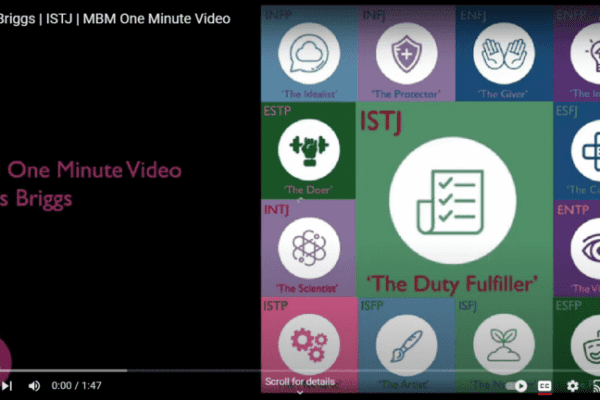
PART II: ISTJ Meaning

Sticky Learning ® is 7 times more effective than 1-day training courses. Plus, you will get a Chain of Evidence proving your Return on Investment. Discover soft skills training that changes behaviours long term.

Meet ISTJ – “The Duty Fulfiller”
The acronym of ISTJ stands for:
- ‘I’ for Introvert
- ‘S’ for Sensor
- ‘T’ for Thinker
- ‘J’ for Judger
Now, the Duty Fulfiller doesn’t like to waste time. Actually, for them, it’s all about creating efficient systems. Additionally, ISTJs never give up until they finish a task they’ve set their mind to and they tend to be pragmatic. So, let’s get down to business and really get to know the ISTJs.
ISTJ Personality Type
Well, as one of four guardians, ISTJs are serious, practical, logical, and organised. So, does that sound like someone you know?
In similar fashion, they have the following stand-out features.
#1: Driven to Create Order
Here, we see their need for organisation take over. Ideally, they have structure and systems in place that they greatly rely on.
#2: Have Great Memories
Next, we see a very useful feature ISTJs have. They have great memories. First, they can recall information and data very easily. Also, they can see patterns that others might miss. So, this helps identify possible mistakes that need correcting.
#3: Hardworking
Then, this personality type is known for being hard working and dedicated to their team, goals and achieving results. As such, we rely on them. And, in turn, they are highly dependable and a strength to any team.
Here, we have some common words that best describe the ISTJ personality type.
- Honest
- Reliable
- Driven
- Independent
- Direct
- Trustworthy
- Organised
- Realistic
Remember, each personality type has their own features. However, there are some common overlaps that occur because of the combination of the 4 elements of the profile.

Is ISTJ a Rare Personality Type?
Realistically, ISTJ is the most common personality type among men and ranks number six among women. In fact, here are some statistics:
- First, 13% of the population are ISTJs
- Next, 16.4% of ISTJs are men
- Then, 6.9% of ISTJs are women
Interestingly, a recent MBTI research shows that 56.8% of the population prefers introversion. Is the tide shifting towards a more introverted world? And is it due to the coronavirus and the ‘sudden’ interest in freelance jobs skyrocketing?
Are ISTJ Females Rare?
We previously mentioned that ISTJ females make up 6.9% of women.

But, did you know that ISTJ females tend to be misunderstood? Dare I say, they have more dominant masculine energy? Well, look at the facts: they are introverts, thinkers, and judgers. All three are more masculine features.
So, Introversion, Sensor, Thinker, and Judger seem more masculine. In comparison, Extraversion, Intuition, Feeling, and Perceiving are more feminine traits. This shows us the most masculine type is ISTJ and the most feminine type is ENFP.
Actually, ISTJ women show the following traits:
- Like traditional gender role relationships
- Are direct and tell things like they are
- Are fixers and keep on working and fixing
- Independent
- Don’t allow feelings to control their decisions
- Can be quite competitive
The Strengths of ISTJ
#1: System Creators:
First, ISTJ are the most efficient achievers. Having spent their childhood observing and introspecting, when they enter the workforce they start building the system that will propel them (and others) to success.
#2: Consistent, Reliable, and Responsible:
Also, ISTJ are nothing but consistent. They enjoy their routines and have the will of a titan. As a result, no obstacle stands in their way when they have set their sights on a goal.
#3: Sticklers to the Rules:
Here, we see them use the rules and regulations to their advantage. In this way, they have the structure in place that brings out the best in them.
#4: Logical and Practical:
Then, another ISTJ strength is their logic and practicality. If you are familiar with the 6 thinking hats by Edward Debono, ISTJs wear the White hat.
So, in a world of constant change, ISTJs are your best bet for a steady and successful future.
The Weaknesses of ISTJ
#1: Judgmental and insensitive:
Firstly, ISTJ put goals before humans. As a thinker, they prioritise facts and systems over personal values. Now, this can sometimes lead to insensitive remarks and judgment. Also, they tend to be somewhat direct. And, for the sensitive souls who prefer to be right rather than to know the truth, it can backfire.
#2: Determination:
Huh? How is that a weakness you might ask?
Well, it’s just that ISTJs take their determination to the extreme sometimes. In fact, it can be borderline obsession. Now, while obsession can be healthy (that’s how most successful people achieve their goals), it can sometimes burn them out. Additionally, they can stay stuck in a rut, unable to dig themselves, out just because they want to do it their own way.
#3: Highly Competitive:
Finally, ISTJ can also be very competitive. So, while competition can be healthy, they take it to the extreme, again. And what about their rigidity? It’s hard to work with ISTJs as they are prone to follow the rules to the letter. Also, they expect others to work the same way.
What Do ISTJs Not Like?
#1: Wasting time socialising:
Commonly, ISTJ will think: “I mean, what’s the point? Chit chat here, chit chat there, it’s just a waste of time.”
ISTJs have other things to do such as optimising processes and systems. So, don’t blame ISTJ for not liking to socialise.
#2: Talking about ideas:
In similar fashion, they will think: “Don’t tell me about an idea, show me it can work. Ideas and theories are for the dreamers, I have no time to waste on such ‘trivial’ thoughts.”
Actually, as fervent defenders of productivity, ISTJs only rely on facts. As such, they leave the creative thinking to others so they can concentrate on the practicalities.
#3: Lack of systems:
Then, ISTJs will often wonder: “Seriously? How do you expect to achieve your goals?”
Well, talent is great but it will only get you so far. Consequently, ISTJs believe that it is systems and unrelenting action that will help you achieve your goals.
Some other things that ISTJ don’t like are unfamiliarity and uncertainty.
Why Are ISTJ Attractive?
Now, while ISTJs appear cold when we are not in their inner circle, once we become part of that inner circle we might fall head over heels and be captivated by the attractiveness of ISTJs.
ISTJs are attractive for their deep care, attentiveness, their willingness and ability to solve any and all our problems.
Also, another attractive feature of ISTJs is our ability to rely on them. As such, they become the rock we can lean on. In fact, we know we can count on them no matter what, where, or when – they will always be there – devoted and loyal. Naturally, ISTJs can be so grounded it makes us feel safe.
In short, we are attracted to ISTJs for the following reasons:
- Deep care & attentiveness
- Willingness & ability to solve all problems
- Reliability & dependability
- Devotion & loyalty
And now, let the wedding bells start ringing!
PART III: ISTJ Compatibility
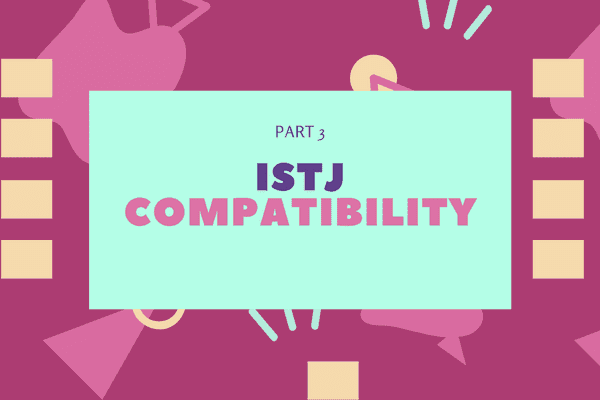
So, who should the ISTJ marry? Who is ISTJ compatible with?
Well, Guardians are most compatible with Artisans. As a Guardian, ISTJ has the best flings and passionate short-term relationships with ESFPs. On the other hand, they have the best long-term lovey-dovey relationship with ISFP.
As a rule of thumb, it’s important to have a balance of two traits in common and two complementary. The two in common will help you feel at home with the person. Then, the two complementary will give you the friction to keep the sparks alive.
However, choosing the right combination to find your ‘almost’ ideal match will depend on your upbringing, your current environment (and if you want to change it), and the goals you want to achieve in life.
So, taking the example above, the ESFP will bring extraversion, a more objective way of looking at things and a more adventurous life for you and into your relationship. Now, while this combination is intriguing in the short term, it can exhaust you in the long haul.
Recently, an interesting research showcased how ISTJs are a complex personality type when it comes to dating and relationships. The study explored four different factors for compatibility: communication, passion, friendship, and partnership.
Also, this same study shows that whenever it ranked high in one, it ranked lower in another. So, what are you choosing? Or rather, whom are you choosing?
ISTJ vs INTJ
Primarily, ISTJ and INTJ can be a powerful couple. They can complement each other in a wonderful way.
ISTJ and INTJ share three types: introvert, thinking, and judging. This translates into:
- First, as Introverts: they understand giving each other space and enjoying small groups.
- Then, as Thinkers: they both think logically.
- Also, as Judgers: they both enjoy their routines, plans, and predictable behaviours.
Then, when it comes to the letter that separates them, it can only help them grow stronger together. Compatibly, ISTJ brings the facts and details to INTJ, while INTJ brings the ideas and vision to ISTJ.
After all, we need both vision and details. We need the vision to know the destination and we need the details to know how we’re going to get there.
Now, ISTJ and INTJ have the same energy, make similar decisions, and organise similarly. On the other hand, they take in information differently. So, while ISTJ follows rules we cannot say the same about INTJ.
Naturally, ISTJ and INTJ think and work complementarily and relate similarly.
ISTJ Love Personality
On one side, with ISTJs, you can expect stability. Certainly, you will feel safe and secure in your relationship.
On the other hand, if you’re expecting a partner who will have deep conversations under the stars, walk barefoot on the beach holding hands, or give you a massage, you are in for a rude awakening. That’s because, ISTJs are the practical partner, not the romantic type. Here, they will fix you, fix your problems, and give you advice. However, they will steer clear of all the emotional mumbo jumbo. ISTJs are very loyal and care deeply, they just show it differently. They can be your rock but not your emotional cushion.
In a relationship, they enjoy the routine, the special rituals you create together. IN saying that, this is a practical relationship rather than an emotional one.
PART IV: ISTJ Learning & Growing
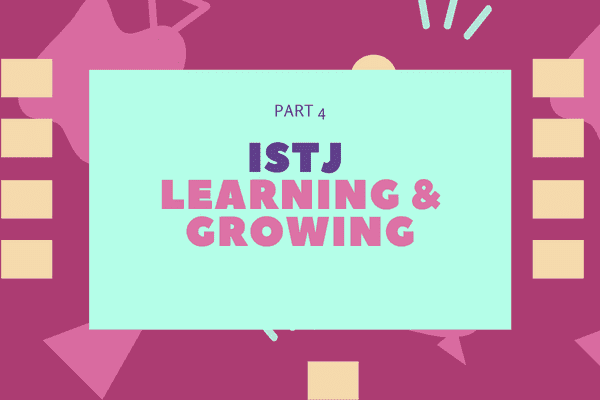
But first, a little glimpse into how you became you.
The 4 Stages of ISTJ Development
With 4 functions for each profile type, we see each as the dominant feature at different development stages. So, let’s see how ISTJ develop through the years.
#1: Childhood to Puberty
To begin with, we look at the early years. So, at this first stage, we see the development of the Introverted Sensing function. As such, as see some of the following developmental traits.
- First, they have a preference for games and activities, rather than fairy tales and make-believe.
- Next, they want real world experience, such as touching and seeing, instead of just from a book.
- Also, they show awareness when interacting with others.
- Then, they are openly aware of their surroundings, at home and at school.
It is important for this stage to develop well. Otherwise, later they make decisions or take actions without properly analysing the facts.
#2: Puberty to 30
Next, they develop the auxiliary function, Extraverted Thinking. For this, the development happens through puberty and into their 20s. During this time, we see some of the following qualities emerging.
- First, they become frank, direct and objective.
- Also, they start making more judgment calls.
- Then, they develop better decision-making skills.
- Next, their intellectual curiosity increases.
- Finally, at this stage, they start to break things down to better understand how they work.
Here, this development stage allows them to better use their experiences and stored data to understand the world around them.
#3: Age 30 to Midlife
Then, at the third stage, they develop the aspects of their tertiary function, Introverted Feeling. Ideally, what you see happening here are some of the following changes.
- Firstly, they show increased sensitivity and compassion for others.
- Secondly, they display new-found expressions of love and emotion to those close to them.
- Also, they develop improved recognition and praise.
- Additionally, they become more aware of the feelings of others by observing their verbal and non-verbal ques.
As a result, they seem more approachable and understanding than in earlier years.
#4: From Midlife Onwards
Finally, the least dominant function, Extraverted Intuition, which develops from midlife onwards. Here, we see them:
- Now, we see them more relaxed approach to new ideas and experiences.
- Also, they are ready to have more leisure and relaxion time.
- And, they try to be a little more spontaneous than at other stages of development.
Now, there you have the 4 stages of development. So, where are you currently in terms of the stages? And, what areas would you still like to work on as an ISJT?
How E & I Can Help Complement Each Other
Here, Extroverts can help introverts open their sphere of influence by:
- Moving into action
- Broadening their ideas
- Amplifying their energy focus
- Expanding their Interaction
- Widening their network
- Providing extensive information
Then, Introverts can help extroverts centre themselves by:
- Reflecting more
- Scanning through ideas
- Deepen their calmness
- Strengthen their concentration
- Deepen their friendships
- Listening to others
How S & N Can Help Complement Each Other
Next, Sensors can help intuitivist be more practical by:
- Adding more facts
- Providing more practical and realistic information
- Looking deeper at the details
- Applying their experience when solving problems
- Focusing on what needs attention now
- Focusing on the present
Also, Intuitive can help Sensors recognise the inter-connectedness by:
- Looking at new ideas
- Creating change
- Being open to looking at trends
- Applying insight and pattern recognition to solving problems
- Focusing on long-term goals instead of short-term goals
- Focusing on future possibilities
How T & F Can Help Complement Each Other
Undoubtedly, Thinkers can help Feelers get clearer and more direct by:
- Analysing the implications and consequences
- Being consistent with rules
- Standing firm on important principles
- Being more objective when making decisions
- Having specific criteria that allow a clearer thinking process
In comparison, Feelers can help Thinkers reconnect by:
- Predicting how others will react and feel
- Making individual exceptions when necessary
- Accepting human-centred values
- Allowing better cooperation and collaboration
- Creating a more harmonious environment
How J & P Can Help Complement Each Other
Now, Judgers can help Perceivers be more productive by:
- Being more organised and decisive
- Sharing decisions and moving ahead
- Being in control
- Having closure
- Focusing on tasks and goals
- Providing clear expectations and timelines
And finally, Feelers can help Judgers be open to possibilities by:
- Being more flexible and adapting better
- Dealing with situations as they arise
- Embracing new experiences
- Being open to options
- Being open to new information
- Accepting change
Great points, right? Now, as an ISTJ, your opposite would be ENFP. So, I’d like to invite you to choose one point from each of your opposites (that makes 4 points), develop them. Then, make them part of you.
How to Communicate With Your ISTJ Manager, Colleague, or Romantic Partner

Do you want to get the most out of your ISTJ colleague/employee/boss, or romantic partner? Actually, it’s simple, just act as they would. Then, they will love you for it. So much so, that you will see their productivity skyrocket, their affection for you increases, and more.
#1. The 6 ISTJ Rules for the Extrovert (rule 0: no open space)
Here, let’s make sure we understand how Extroverts can best relate to ISTJs.
- Practice active listening.
- Think before you speak, if you must speak, let them know you are thinking out loud.
- Choose a time and place to communicate with minimum distraction.
- Pause and wait for a response, don’t jump in to fill the silence, especially with small talk.
- Don’t come across as imposing or demanding of an immediate response.
- Avoid making immediate decisions.
#2. The 6 ISTJ Rules for the Intuit (rule 0: dream a little, you are allowed)
Now, it’s important for the Intuit to know what best practices to follow.
- Provide step-by-step, detailed information on specific tasks (share the facts before giving the big picture).
- Provide as many concrete facts and examples to prove your ideas (and I mean to be super generous).
- Share more facts and observations (tables, graphs, infographics, they are all welcome).
- Be organised in your presentation, and sequentially present your thoughts and findings (don’t just share links and ideas).
- Remember that others might not seek change – be open to sticking to a plan.
- Assess what is working well as well as what needs to be changed.
#3. The 6 ISTJ Rules for the Feeler (rule 0: people buy emotions, not facts)
Then, these points are for the Feelers to connect with ISTJs best.
- Take the time to get to know ISTJs and develop a rapport with them.
- When you are listening, avoid criticism.
- Remember to be friendly and offer support and encouragement.
- While honest feedback is important, remember to provide it gently and to critique the behaviour instead of the person – acknowledge don’t analyse feelings and values.
- While focusing on your tasks and objectives, remember that individuals are also involved in the situation – adding a personal touch would go a long way.
- Focus on creating a win-win situation, not everyone likes competition.
#4. The 4 ISTJ Rules for the Perceiver (rule 0: be on time and follow the rules)
Finally, the Perceiver will get better results using these top tips.
- Do whatever it takes to stick to the agreed schedules and deadlines.
- Prepare the Judger about possible changes, they dislike surprises – that way they can include the possible change in their calendar.
- Take a decision based on the information you already have, it’s better to apologise rather than regret a missed opportunity – just do something, anything really.
- Use lists and action plans to inspire you to action on specific tasks.
What stresses ISTJ?
Now, it’s always important to know what our stress triggers are. But, do you know what stresses ISTJs? Well, let’s have a look.
First, the 5 stressors linked to their Introversion:
- Working with others
- Talking on the phone a lot
- Interacting with others often
- Having to act quickly without reflection
- Too many concurrent tasks and demands
Now, the 4 stressors linked to their Thinking:
- Adjusting to personal preferences and needs
- Focusing on the positive of a situation
- Making decisions based on values and empathy
- Answering questions that seem inappropriate
And, if you are an ISTJ struggling with stress, try to meditate and do breathing exercises to lessen your overthinking. Or better yet, go for an intense physical activity.
Up for a challenge? I would like to invite you to work on one of the points mentioned so that you are in control of your stressor rather than them controlling you.
And remember, “Rome was not built in a day.” So, take it one step at a time. And, every time, do one smaller step.
Part V: ISTJ Careers
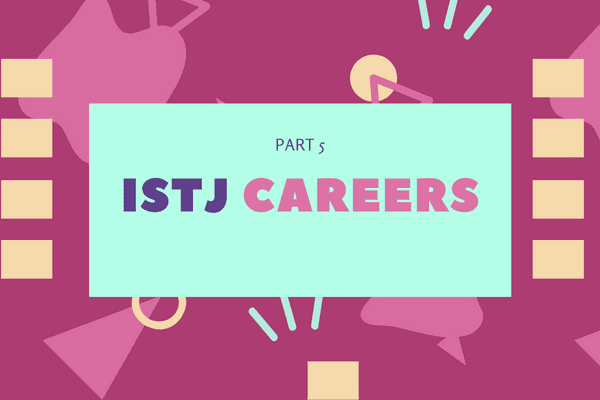
Naturally, ISTJs thrive in a conventional and traditional career that offers stability, routine day-to-day, and a slow-paced environment where processes must be followed and implemented. They rely on facts and experience. Also, ISTJ will put forth their spatial and system intelligence in whatever career they find themselves in.
Let’s Have a Look at Some of the Best ISTJ Career Matches by Categories:
Business & Financial Positions:
- Bank Manager
- Data Analyst
- Quality Insurance Manager
- Business Analyst
- Project Manager
- Financial Auditor
- Accountant
- Lawyer
- Military Officer
Information Technology Positions:
- Software Developer
- Information Security Analyst
- Logistician
- Software Developer
Science & Health Positions:
- Surgeon
- Dentist
- Laboratory Technician
- Engineer
And, according to Indeed – one of the top job boards in the world, these are the top seven ISTJ careers:
- Business analyst
- Supply chain manager
- Certified public accountant (CPA)
- Dentist
- Bank teller
- Military officer
- Inspector
So, do you fancy any of those roles?
Firstly, as an ST, your main strength is creating the most efficient processes and acting upon them to achieve the goals. It’s all about being effective. As such, you solve problems and make decisions using your ST functions (remember the 5 values, which will go a long way to know your ESTP career path).
So, with S, you tune in to facts, sensors, and seek practical actions related to the problem. Then, with T, you see where the decision fits with the vision and the systems of the organisation and assess the effect on both. Then, you determine how to act to get to your solution.
ISTJ Leadership Style
The practical-action-oriented leader. Responsible, reliable, and system-oriented, you can’t have a more dependable leader. ISTJs are more task-oriented at work and might brush aside team spirit for the sake of achieving the goal.
Empowered by your actions, system thinking, and stability, you are a rock among leaders. In fact, because of these qualities, people know they can depend on you to accomplish any task. Your constant improvement of systems and action are music to your followers who loves to work on a proven system and achieve their goals.
However, some ISTJ might take their strengths to the extreme, turning them into their weakness. Now, while it’s great to rely on your skills and area of expertise, it’s also important to expand and try new things to improve even more your processes.
Therefore, one way to overcome this challenge would be to surround yourself with an intuitive and perceiving team that will help with the vision and exploring.
Part VI: Fun Facts

ISTJ Lifestyle & Hobbies
Now, let’s have a look at the type of activities and hobbies ISTJs commonly enjoy.
- Reading
- Playing computer games
- Watching sports
- Doing physical activities
- Intellectual games like risk or chess
ISTJ Quotes
Remember how ISTJs are logical, pragmatic, and organised? Well, perhaps one of these quotes will help you relate:
“My alone feels so good. I’ll only have you if you’re sweeter than my solitude” – Warsaw Shire
“He who labours diligently need never despair: for all things are accomplished by diligence and labour.” – Menander
“Failure is simply the opportunity to begin again, this time more intelligently.” – Henry Ford
“It’s better to look ahead and prepare than to look back and regret.” – Jackie Joyner-Kersee
“Time goes on. So, whatever you’re going to do, do it. Do it now. Don’t wait.” – Robert De Niro
And here are some quotes from some of my favourite ISTJ characters:
“There is no good and evil. There is only power and those too weak to seek it.” – Lord Voldemort from Harry Potter
“What we do in life… echoes in eternity.” – Maximus, Gladiator
“I’m strong enough and smart enough for anything you throw at me.” – Barbara Gordon “Batgirl”, DC Comics
“You need trust to have a truce.” – Brienne of Tarth, Game of Thrones
Famous ISTJ People
ISTJs have numerous famous people, so, let’s have a look.
Entertainment industry
- Sean Connery
- Matt Damon
- Natalie Portman
- Robert De Niro.
Entrepreneurs
- Jeff Bezos
- Peter Thiel
- Warren Buffet.
Politics
- Angela Merkel
- Richard Nixon
- Calving Coolidge
- Augustus
- George Washington
Other Notable Mentions
- Sigmund Freud
- Henry Ford
Wow! Talk about being in good company. Still curious? Then, take a look at PersonalityMax for other famous ITSJs.
ISTJ Fictional Characters
Here, let’s see some ISTJ fictional characters.
- Maximus (Gladiator)
- Hermione Granger (Harry Potter)
- Ned Stark (Game of Thrones)
- Elsa (Frozen)
- Thorin (Lord of the Rings)
- Zazu (The Lion King)
- Bagheera (The Jungle Book)
Then, what about ISTJ anime characters?
- Aquila Marin (Saint Seiya)
- Violet Evergarden (Violet Evergarden)
- Shintaro Midorima (Kuroko’s Basketball)
- Ten Shinhan (Dragon Ball Z)
If you don’t resonate with them, take your pick with the ISTJ Personality database. They have a comprehensive ISTJ famous people and ISTJ fictional characters list for you to look at. And one of them might surprise you!
ISTJ Action Plan
Ideally, you now know yourself better. Therefore, let’s help you step into the world, your new world, with an action plan. Undoubtedly, we want to make sure that you are the best version of yourself.
Here, we at Making Business Matter strongly support personal and professional growth.

As a manager, colleague, or partner working as a supplier, we want to help you by giving you an action plan specially created for ISTJ supply managers working in the UK.
In our training, you will learn about work-based activities, receive a roadmap for line managers to support their teams, and our 5-level evaluation (chain of evidence) to show the ROI of our training (they stick!).
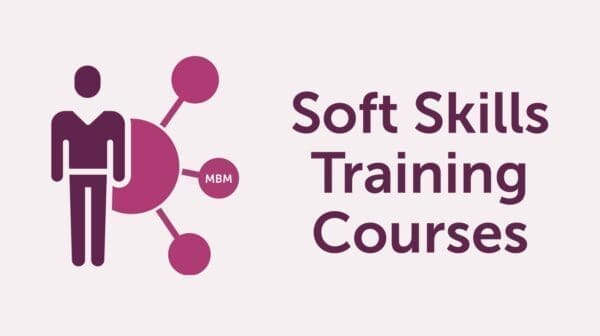
So, stop everything you are doing and act now. Whether you are at work or home, ask the people you are surrounded by to do a small project with you for the next 10 minutes. Remember, it can be anything, from designing a marketing campaign to cleaning a room.
Here, the key is to divide the teams into two groups: extroverts and introverts. However, your goal is to observe. Then, after you do the exercise, send us a LinkedIn message to receive feedback.
Conclusion
ISTJ seeks Internal Order. ISTJ seeks Competence. They are thorough supporters of processes and order.

In this complete guide, you discovered MBTI in general. You also discovered the ISTJ meaning, your character type (ISTJ), your partner’s ISTJ personality type, or your colleague’s ISTJ character.
Also, you found out if an ISTJ female is rare. Now, you intimately know many aspects of ISTJ: strengths, weaknesses, how to communicate with an ISTJ to get the most out of the relationship. Also, you know what do ISTJs not like, who is ISTJ most compatible with, and what and how to develop to become the best version of yourself.
Additionally, you discovered about ISTJ famous people, ISTJ anime characters, and ISTJ fictional people. Hopefully, you took the ISTJ test. Then, we shared about ISTJ careers and leadership style, the relationship between (ISTJ vs INTJ), and even some ISTJ quotes.
So, send us a message on LinkedIn, and we’ll send you tools, processes, and strategies on how to best cope with today’s changing work landscape such as working from home (no fluff, only making business matter).
Updated: December 2023 by Ailish O’Rourke-Henriette
